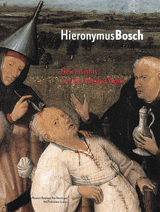
Vink 2001b
“Hieronymus Bosch’s Life in ’s-Hertogenbosch” (Ester Vink) 2001
[in: Jos Koldeweij, Bernard Vermet and Barbera van Kooij (eds.), Hieronymus Bosch. New Insights Into His Life and Work. Museum Boijmans Van Beuningen-NAi Publishers-Ludion, Rotterdam, 2001, pp. 18-23]
In this contribution the Dutch historian Ester Vink summarizes the major results of the book she published in 2001 (see also Vink 2001a) and in which she presented the conclusions from her archival research concerning Bosch. This research did not yield any revealing insights.
In the archival sources Bosch is twice being referred at with the name Jeroen (once in 1480/81 and once in 1487/88). Although the sources don’t provide us with much information about this, it is probable that Bosch worked together with his relatives in a family in which succeeding generations were professional painters.
Partially thanks to his marriage Bosch was more well-to-do than his colleagues, most of them living in middle-class neighbourhoods. Bosch also paid higher taxes (zettingen) than his colleagues. Compared to his immediate neighbours at the Market Square Bosch’s financial position was not exceptional: it was the same as that of the average city councellor or well-to-do craftsman. In terms of social status and material possessings Bosch did not belong to the highest circles in ’s-Hertogenbosch.
In 1475/76 Anthonis, Bosch’s father, was present at a meeting of the Confraternity of Our Lady concerning an altarpiece that the Confraternity wanted to commission. Twelve years earlier Anthonis had been asked to restore the old altarpiece, but it was damaged by a fire before Anthonis could complete his assignment. The wings, on which Anthonis had already started to work, remained untouched, though. In 1480/81 Jheronimus Bosch bought these wings from the Confraternity.
In 1488/89 the Confraternity bought two unpainted altarpiece wings from a certain Goyart Cuper. Later, in 1545/46, Meester Jeronimus (Master Jheronimus, so more than likely Bosch) is mentioned as the painter of the altarpiece wings of the Confraternity (this altarpiece was delivered by Adriaen van Wesel in 1476/77).
Although a lot of things are still unclear about Bosch’s personality, it can be derived from the archival sources that Bosch was considered to be a respected artist by his contemporaries. He was also famous far outside ’s-Hertogenbosch, but still he stayed in his native town, probably because of the family tradition, his workshop and his close ties with the local Confraternity of Our Lady.
Finally a nice detail is that in a (Latin) archival source of 29th March 1515 Bosch is inadvertently called a baker (pistor) instead of a painter (pictor) [p. 20, note 12].
[explicit]